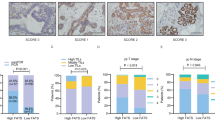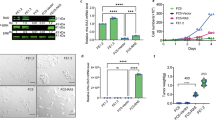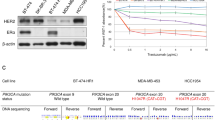Abstract
Ras has long been viewed as a promising target for cancer therapy. Farnesylthiosalicylic acid (FTS), as the only Ras inhibitor has ever entered phase II clinical trials, has yielded disappointing results due to its strong hydrophobicity, poor tumor-targeting capacity, and low therapeutic efficiency. Thus, enhancing hydrophilicity and tumor-targeting capacity of FTS for improving its therapeutic efficacy is of great significance. In this study we conjugated FTS with a cancer-targeting small molecule dye IR783 and characterized the anticancer properties of the conjugate FTS-IR783. We showed that IR783 conjugation greatly improved the hydrophilicity, tumor-targeting and therapeutic potential of FTS. After a single oral administration in Balb/c mice, the relative bioavailability of FTS-IR783 was increased by 90.7% compared with FTS. We demonstrated that organic anion transporting polypeptide (OATP) and endocytosis synergistically drove the uptake of the FTS-IR783 conjugate in breast cancer MDA-MB-231 cells, resulting in superior tumor-targeting ability of the conjugate both in vitro and in vivo. We further revealed that FTS-IR783 conjugate could bind with and directly activate AMPK rather than affecting Ras, and subsequently regulate the TSC2/mTOR signaling pathway, thus achieving 2–10-fold increased anti-cancer therapeutic efficacy against 6 human breast cancer cell lines compared to FTS both in vivo and in vitro. Overall, our data highlights a promising approach for the modification of the anti-tumor drug FTS using IR783 and makes it possible to return FTS back to the clinic with a better efficacy.

Similar content being viewed by others
Log in or create a free account to read this content
Gain free access to this article, as well as selected content from this journal and more on nature.com
or
References
Wang Y, Kaiser CE, Frett B, Li HY. Targeting mutant KRAS for anticancer therapeutics: a review of novel small molecule modulators. J Med Chem. 2013;56:5219–30.
Holderfield M, Morrison DK. RAS signaling: divide and conquer. Nat Chem Biol. 2016;13:7–8.
Kwong LN, Costello JC, Liu H, Jiang S, Helms TL, Langsdorf AE, et al. Oncogenic NRAS signaling differentially regulates survival and proliferation in melanoma. Nat Med. 2012;18:1503–10.
Ledford H. Cancer: the Ras renaissance. Nature. 2015;520:278–80.
Laheru D, Shah P, Rajeshkumar NV, McAllister F, Taylor G, Goldsweig H, et al. Integrated preclinical and clinical development of S-trans, trans-Farnesylthiosalicylic Acid (FTS, Salirasib) in pancreatic cancer. Invest N Drugs. 2012;30:2391–9.
Santen RJ, Lynch AR, Neal LR, McPherson RA, Yue W. Farnesylthiosalicylic acid: inhibition of proliferation and enhancement of apoptosis of hormone-dependent breast cancer cells. Anticancer Drugs. 2006;17:33–40.
Zundelevich A, Elad-Sfadia G, Haklai R, Kloog Y. Suppression of lung cancer tumor growth in a nude mouse model by the Ras inhibitor salirasib (farnesylthiosalicylic acid). Mol Cancer Ther. 2007;6:1765–73.
Bustinza-Linares E, Kurzrock R, Tsimberidou AM. Salirasib in the treatment of pancreatic cancer. Future Oncol. 2010;6:885–91.
Yue W, Wang J, Li Y, Fan P, Santen RJ. Farnesylthiosalicylic acid blocks mammalian target of rapamycin signaling in breast cancer cells. Int J Cancer. 2005;117:746–54.
Badar T, Cortes JE, Ravandi F, O’Brien S, Verstovsek S, Garcia-Manero G, et al. Phase I study of S-trans, trans-farnesylthiosalicylic acid (salirasib), a novel oral RAS inhibitor in patients with refractory hematologic malignancies. Clin Lymphoma Myeloma Leuk. 2015;15:433–438.e2.
Furuse J, Kurata T, Okano N, Fujisaka Y, Naruge D, Shimizu T, et al. An early clinical trial of Salirasib, an oral RAS inhibitor, in Japanese patients with relapsed/refractory solid tumors. Cancer Chemother Pharmacol. 2018;82:511–9.
Riely GJ, Johnson ML, Medina C, Rizvi NA, Miller VA, Kris MG, et al. A phase II trial of Salirasib in patients with lung adenocarcinomas with KRAS mutations. J Thorac Oncol. 2011;6:1435–7.
Tsimberidou AM, Rudek MA, Hong D, Ng CS, Blair J, Goldsweig H, et al. Phase 1 first-in-human clinical study of S-trans, trans-farnesylthiosalicylic acid (salirasib) in patients with solid tumors. Cancer Chemother Pharmacol. 2010;65:235–41.
Yang X, Shao C, Wang R, Chu CY, Hu P, Master V, et al. Optical imaging of kidney cancer with novel near infrared heptamethine carbocyanine fluorescent dyes. J Urol. 2013;189:702–10.
Yi X, Wang F, Qin W, Yang X, Yuan J. Near-infrared fluorescent probes in cancer imaging and therapy: an emerging field. Int J Nanomed. 2014;9:1347–65.
Yang X, Shi C, Tong R, Qian W, Zhau HE, Wang R, et al. Near IR heptamethine cyanine dye-mediated cancer imaging. Clin Cancer Res. 2010;16:2833–44.
James NS, Chen Y, Joshi P, Ohulchanskyy TY, Ethirajan M, Henary M, et al. Evaluation of polymethine dyes as potential probes for near infrared fluorescence imaging of tumors: part - 1. Theranostics. 2013;3:692–702.
Duan L, Wang L, Zhang C, Yu L, Guo F, Sun Z, et al. Role of near-infrared heptamethine cyanine dye IR-783 in diagnosis of cervical cancer and its mechanism. Int J Clin Exp Pathol. 2019;12:2353–62.
Guan Y, Zhang Y, Zou J, Huang LP, Chordia MD, Yue W, et al. Synthesis and biological evaluation of genistein-IR783 conjugate: cancer cell targeted delivery in MCF-7 for superior anti-cancer therapy. Molecules. 2019;24:4120.
Zhang B, Wang H, Shen S, She X, Shi W, Chen J, et al. Fibrin-targeting peptide CREKA-conjugated multi-walled carbon nanotubes for self-amplified photothermal therapy of tumor. Biomaterials. 2016;79:46–55.
Almqvist H, Axelsson H, Jafari R, Dan C, Mateus A, Haraldsson M, et al. CETSA screening identifies known and novel thymidylate synthase inhibitors and slow intracellular activation of 5-fluorouracil. Nat Commun. 2016;7:11040.
Martinez Molina D, Jafari R, Ignatushchenko M, Seki T, Larsson EA, Dan C, et al. Monitoring drug target engagement in cells and tissues using the cellular thermal shift assay. Science. 2013;341:84–87.
Zhai HY, Liu ZP, Chen ZG, Liang ZX, Su ZH, Wang SM. A sensitive electrochemical sensor with sulfonated graphene sheets/oxygen-functionalized multi-walled carbon nanotubes modified electrode for the detection of clenbuterol. Sens Actuators B-Chem. 2015;210:483–90.
Williams HD, Trevaskis NL, Charman SA, Shanker RM, Charman WN, Pouton CW, et al. Strategies to address low drug solubility in discovery and development. Pharmacol Rev. 2013;65:315–499.
Wang SC. PCNA: a silent housekeeper or a potential therapeutic target? Trends Pharmacol Sci. 2014;35:178–86.
Zhu GJ, Song PP, Zhou H, Shen XH, Wang JG, Ma XF, et al. Role of epithelial-mesenchymal transition markers E-cadherin, N-cadherin, beta-catenin and ZEB2 in laryngeal squamous cell carcinoma. Oncol Lett. 2018;15:3472–81.
Wu JB, Shi C, Chu GC, Xu Q, Zhang Y, Li Q, et al. Near-infrared fluorescence heptamethine carbocyanine dyes mediate imaging and targeted drug delivery for human brain tumor. Biomaterials. 2015;67:1–10.
Letschert K, Faulstich H, Keller D, Keppler D. Molecular characterization and inhibition of amanitin uptake into human hepatocytes. Toxicol Sci. 2006;91:140–9.
Tian T, Li X, Zhang J. mTOR signaling in cancer and mTOR inhibitors in solid tumor targeting therapy. Int J Mol Sci. 2019;20:755.
McMahon LP, Yue W, Santen RJ, Lawrence JC Jr. Farnesylthiosalicylic acid inhibits mammalian target of rapamycin (mTOR) activity both in cells and in vitro by promoting dissociation of the mTOR-raptor complex. Mol Endocrinol. 2005;19:175–83.
Wang H, Liu Y, Wang D, Xu Y, Dong R, Yang Y, et al. The upstream pathway of mTOR-mediated autophagy in liver diseases. Cells. 2019;8:1597.
Waring MJ. Lipophilicity in drug discovery. Expert Opin Drug Discov. 2010;5:235–48.
Lindsley CW Lipophilicity. In: Stolerman I, Price L, editors. Encyclopedia of Psychopharmacology. Berlin; Heidelberg: Springer; 2014.
Shi C, Wu JB, Chu GC, Li Q, Wang R, Zhang C, et al. Heptamethine carbocyanine dye-mediated near-infrared imaging of canine and human cancers through the HIF-1alpha/OATPs signaling axis. Oncotarget. 2014;5:10114–26.
Bruce A, Alexander J, Julian L, Martin R, Keith R, & Peter W. Transport into the cell from the plasma membrane: endocytosis. Molecular Biology of the Cell. 4th ed. New York: Garland Science; 2002.
Miller I, Min M, Yang C, Tian C, Gookin S, Carter D, et al. Ki67 is a graded rather than a binary marker of proliferation versus quiescence. Cell Rep. 2018;24:1105–1112.e5.
Stapleton D, Mitchelhill KI, Gao G, Widmer J, Michell BJ, Teh T, et al. Mammalian AMP-activated protein kinase subfamily. J Biol Chem. 1996;271:611–4.
Zhang H, Liu B, Li T, Zhu Y, Luo G, Jiang Y, et al. AMPK activation serves a critical role in mitochondria quality control via modulating mitophagy in the heart under chronic hypoxia. Int J Mol Med. 2018;41:69–76.
Acknowledgements
This work was supported by the projects of National Natural Science Foundation of China [81720108033, 81930114, and 81874367], Natural Science Foundation of Guangdong Province [2018B030322011], and Natural Science Foundation for Distinguished Young Scholars of Guangdong Province [2017A030306033].
Author information
Authors and Affiliations
Contributions
ZQL and LLL conceived the ideas and designed the experiments. QJH, MLY, JHD, JJY, YMZ, XRZ performed the experiments and analyzed the data. QJH prepared the manuscript. ZQL, LLL, FXZ, and GCL provided critical revisions to the manuscript. YW, XXQ, ZYH, DFP, and YG provided technical supports. All authors read and agreed on the final version of the manuscript.
Corresponding authors
Ethics declarations
Competing interests
The authors declare no competing interests.
Supplementary information
Rights and permissions
About this article
Cite this article
Huang, Qj., Liao, Gc., Zhuang, Xr. et al. Ras inhibitor farnesylthiosalicylic acid conjugated with IR783 dye exhibits improved tumor-targeting and altered anti-breast cancer mechanisms in mice. Acta Pharmacol Sin 43, 1843–1856 (2022). https://doi.org/10.1038/s41401-021-00775-5
Received:
Accepted:
Published:
Issue date:
DOI: https://doi.org/10.1038/s41401-021-00775-5
Keywords
This article is cited by
-
Carrier-adjuvanted immunostimulator to boost photodynamic immunotherapy by downregulating PD-L1 and impairing ATP hydrolysis
Science China Materials (2025)



